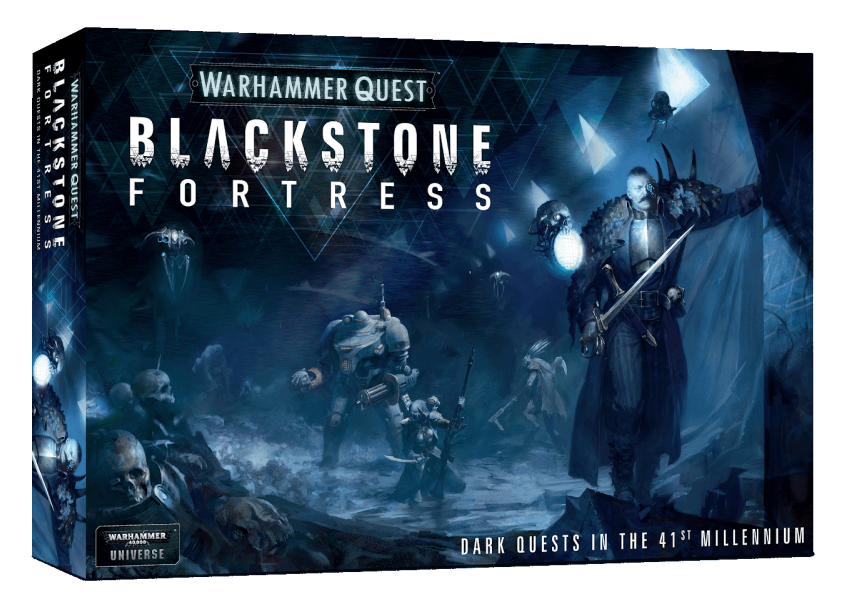 Players: 1-5
Players: 1-5
Cooperative
Blackstone – come for the archeotech, stay for the adventure!
The resurgence of the tabletop games market has certainly not gone unnoticed by the giant that is GamesWorkshop; after relinquishing their IP with Fantasy Flight, they have waded in with blockbuster titles such as The Silver Tower, Necromunda and Warhammer Underworlds, games that combine immersive game mechanics with GamesWorkshop’s customary flair for jaw-dropping aesthetics.
Blackstone Fortress encapsulates this approach, but takes it a little further. The contents are impeccable; from the chunky card stock to the illustrated booklets, there is a sense of pride and passion that has gone into the design, and that is to say nothing of the miniatures. Here we have a collection of protagonists and antagonists that are a triumph of imagination and skill, but also scratch a special itch for fans of the Warhammer 40,000 universe.
Delving deep into the eldritch abyssal chambers of the Blackstone Fortress, an ancient behemoth of unknown origin, are a plucky band of heroes and anti-heroes. Many of these characters have revealed themselves from the fringes of the lore to seek archeotech, each for their own peculiar purposes.
Roll Call!
- a swashbuckling Rogue Trader;
- a robot with Abominable Intelligence;
- a space bishop and his follicly challenged flaming chainsword wielding companion;
- a pair of light fingered halfling snipers;
- a Navigator with a great hat;
- a pair of Xenos – a Kroot Carnivore; and
- an Aeldari Ranger, who believes the Blackstone might just be the key to saving her dying world.
Docking their craft to Precipice (a villainous hive of flotsam and space-jetsam) players strike out on perilous expeditions into the Blackstone Fortress, intent on treasure and unlocking the secrets within.
“Expect to be assailed by Chaos Beastmen, warp-wielding Rogue Psykers and (naturally) 10,000 year old super soldiers”
Waiting inside are a terrifying conglomeration of hostiles. Representing the first tier of enemies are Traitor Guardsmen, fell soldiers bedecked in animal fur and scavenged armour, and the freaky Negavolt Cultists. They are not to be sniffed at. The initiative track randomly determines which explorers or hostiles get to act. If it looks bad, players can perform a ‘gambit’ to move themselves to a more advantageous position. Players must also support one another with overwatch, use cover and make the most of their unique abilities to thwart the tide of evil that sneaks, charges, aims or onslaughts, depending on the will of the Blackstone Dice that acts as the game’s internal intelligence. Each of the explorers’ vessels can also offer remote support to give your explorer the edge, offering nifty things, like a targeting matrix (a cheeky re-roll), for when you really need them.
Having overcome these odds, players gratefully return to Precipice, presumably for a few restorative beverages, but primarily to heal, augment themselves with weaponry, bionics and all manner of bonkers equipment that one might expect from the Grim Darkness of the Far Future.
Players can also combine their intel to determine the location of a Stronghold, one of a number of particularly nasty zones within the Blackstone that might just hold the answers they are looking for. By this point, expect to be assailed by Chaos Beastmen, warp-wielding Rogue Psykers and (naturally) 10,000 year old super soldiers. At the head of all of them is Obsidius Mallex, the Black Legion commander. He would like to alleviate some of his frustration at being marooned inside this alien labyrinth. Yes he would. With his giant hammer.
“Players can oscillate between congratulating themselves for implementing surefire tactics… and finding themselves in a galactic mother-load of bother”
It will take more than tactics and resources for an intrepid band to make it through. The ‘inspiration’ mechanic enables your explorer to go into a kind of overdrive. Once activated, turn over your explorer’s card to find a whole new bunch of stats, buffing them considerably. The only question is, do you activate your inspiration now, or hold on to it until you really need it?
The element of uncertainty makes these kind of decisions commonplace, with the Blackstone throwing all kinds of curveballs your way. For example: In the event phase the Blackstone might determine that you won’t be getting any Destiny Dice (an important dice pool that can turn things in your favour), then suddenly that smouldering pile of enemies gets reinforcements! In this way, players can oscillate between congratulating themselves for implementing surefire tactics and finding themselves in a galactic mother-load of bother! One moment you’ll have a grip on the situation: laying traps, denying hexes with flaming promethean and keeping enemies at bay with a succession of critical sniper shots, the next you’ll be smarting from grievous wounds, leaping to your fellow explorers’ aid and bundling KO’d friends into the Maglift with frantic abandon. Alternatively, you might suddenly realise that your own objectives take precedence over the safety of one of your new found companions – he is a xeno/robot/mutant/lunatic after all…
Blackstone Fortress doesn’t have the same sense of story as Warhammer Quest: The Silver Tower – at no point will you find yourself taking on the role of a grand-eloquent narrator to drive the story onward, but there is no need. Blackstone Fortress is cinematic, gritty and bombastic enough to forego any need for players to resort to text. Who could forget when the Kroot Tracker leapt to Pious Vorne’s aid when the Traitor Sergeant charged burning through the cordon? Or when Amallyn Shadowguide risked all to allow her companions to escape a pack of hungry Ur-Ghuls?
All of these moments contribute to a great experience and one that, even after several late nights and many hours of happy gaming with friends, we have yet to complete. The secret envelope remains unopened and with it, presumably, the secrets of the Blackstone Fortress.



 Players: 1-5
Players: 1-5